Corporate Finance: Sources of Finance and Capital Structure of Nestle
VerifiedAdded on 2023/01/12
|12
|3579
|54
Report
AI Summary
This report provides a comprehensive analysis of Nestle (Malaysia) Berhad's corporate finance strategies. It begins with an introduction to corporate finance, emphasizing shareholder wealth maximization. The report then explores the various sources of long-term finance available to companies, including equity capital, preference capital, debentures, and term loans, highlighting their advantages and disadvantages. A detailed discussion on the shareholder wealth maximization model is presented, emphasizing its importance in financial decision-making. The capital structure of Nestle is examined, including the debt-to-equity ratio and interest coverage ratio. The report also includes the computation of the Weighted Average Cost of Capital (WACC) for Nestle (Malaysia) Bhd and discusses capital structure theory in relation to the company. The report uses financial ratios to analyze Nestle’s capital structure and leverage. Overall, the report aims to provide a clear understanding of Nestle's financial management practices and their impact on shareholder value.
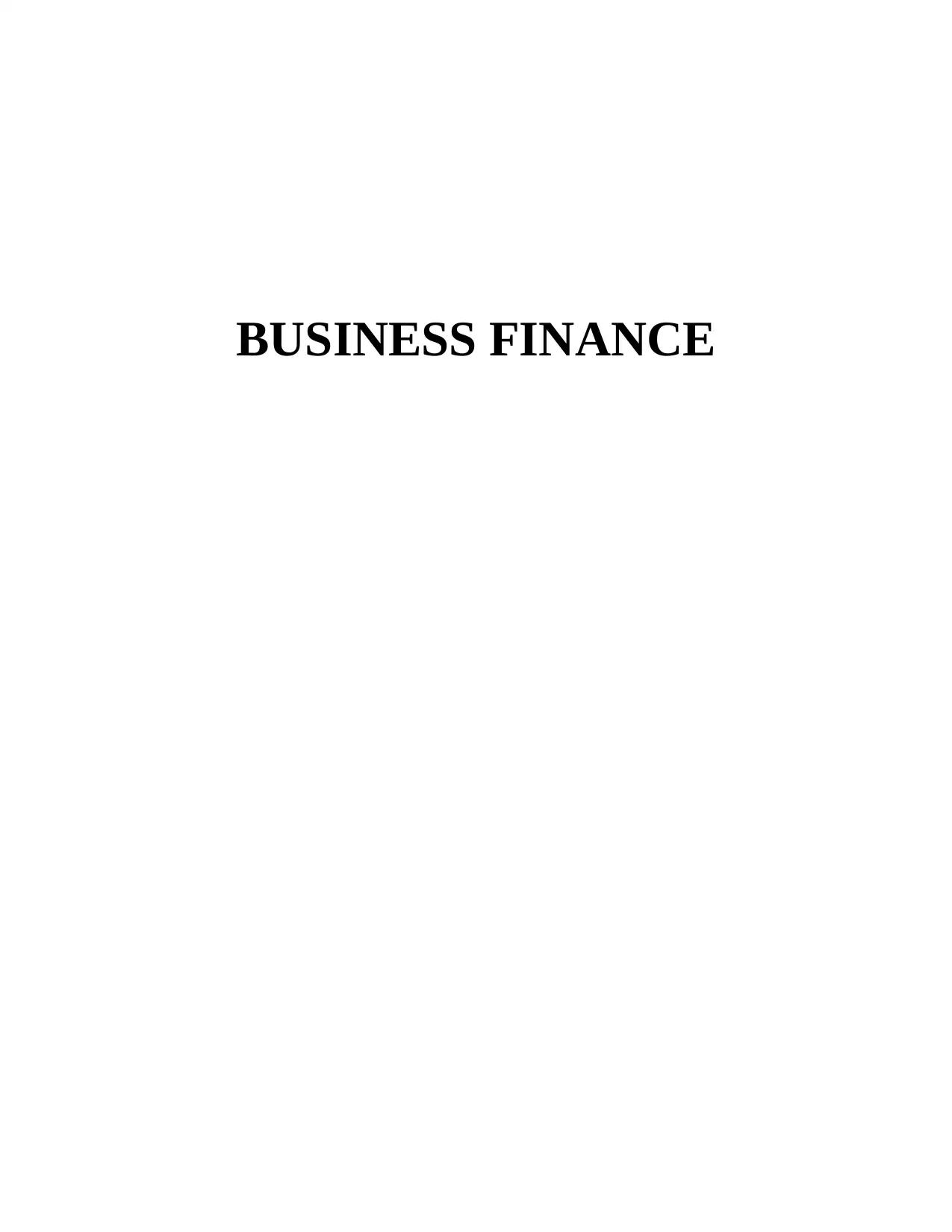
BUSINESS FINANCE
Paraphrase This Document
Need a fresh take? Get an instant paraphrase of this document with our AI Paraphraser
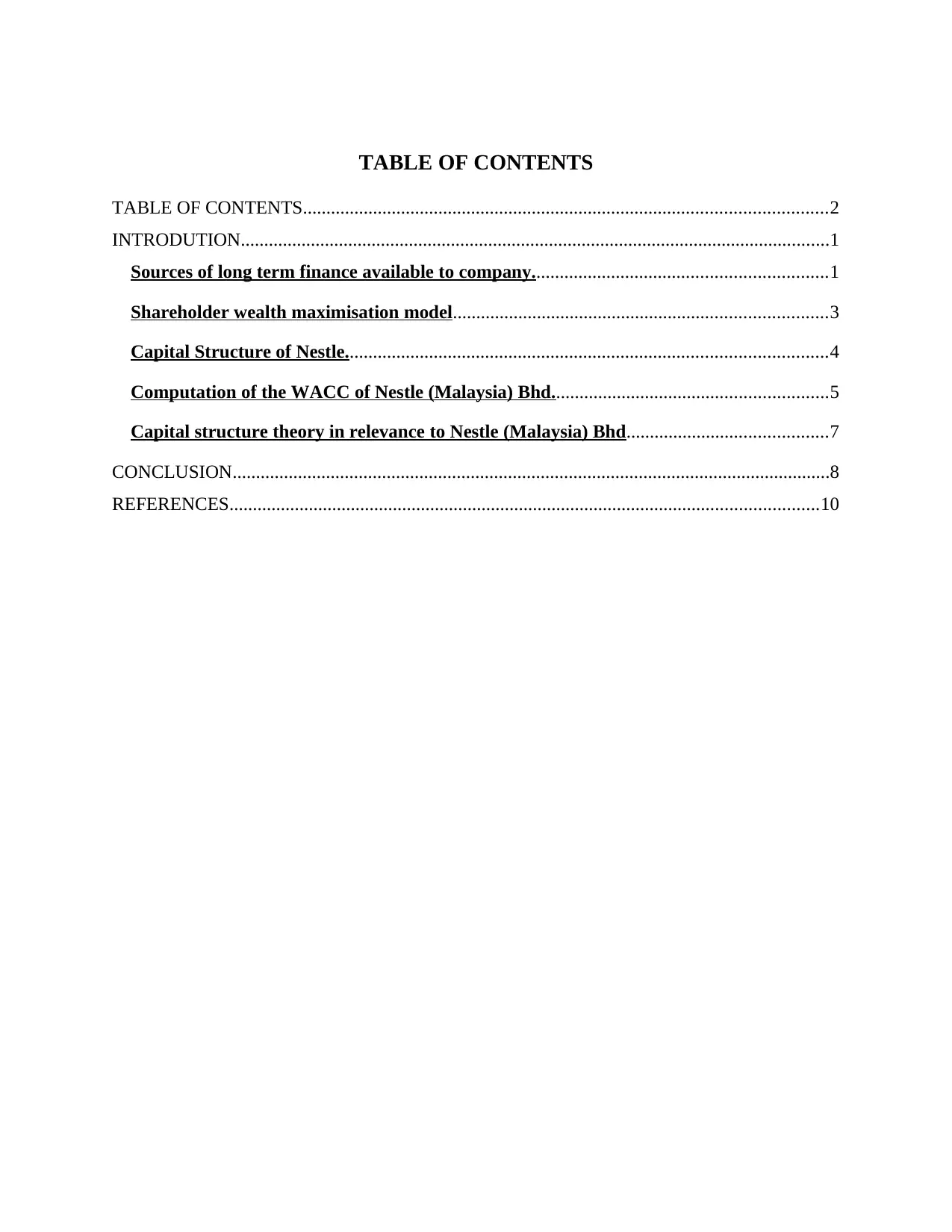
TABLE OF CONTENTS
TABLE OF CONTENTS................................................................................................................2
INTRODUTION..............................................................................................................................1
Sources of long term finance available to company...............................................................1
Shareholder wealth maximisation model................................................................................3
Capital Structure of Nestle.......................................................................................................4
Computation of the WACC of Nestle (Malaysia) Bhd...........................................................5
Capital structure theory in relevance to Nestle (Malaysia) Bhd...........................................7
CONCLUSION................................................................................................................................8
REFERENCES..............................................................................................................................10
TABLE OF CONTENTS................................................................................................................2
INTRODUTION..............................................................................................................................1
Sources of long term finance available to company...............................................................1
Shareholder wealth maximisation model................................................................................3
Capital Structure of Nestle.......................................................................................................4
Computation of the WACC of Nestle (Malaysia) Bhd...........................................................5
Capital structure theory in relevance to Nestle (Malaysia) Bhd...........................................7
CONCLUSION................................................................................................................................8
REFERENCES..............................................................................................................................10
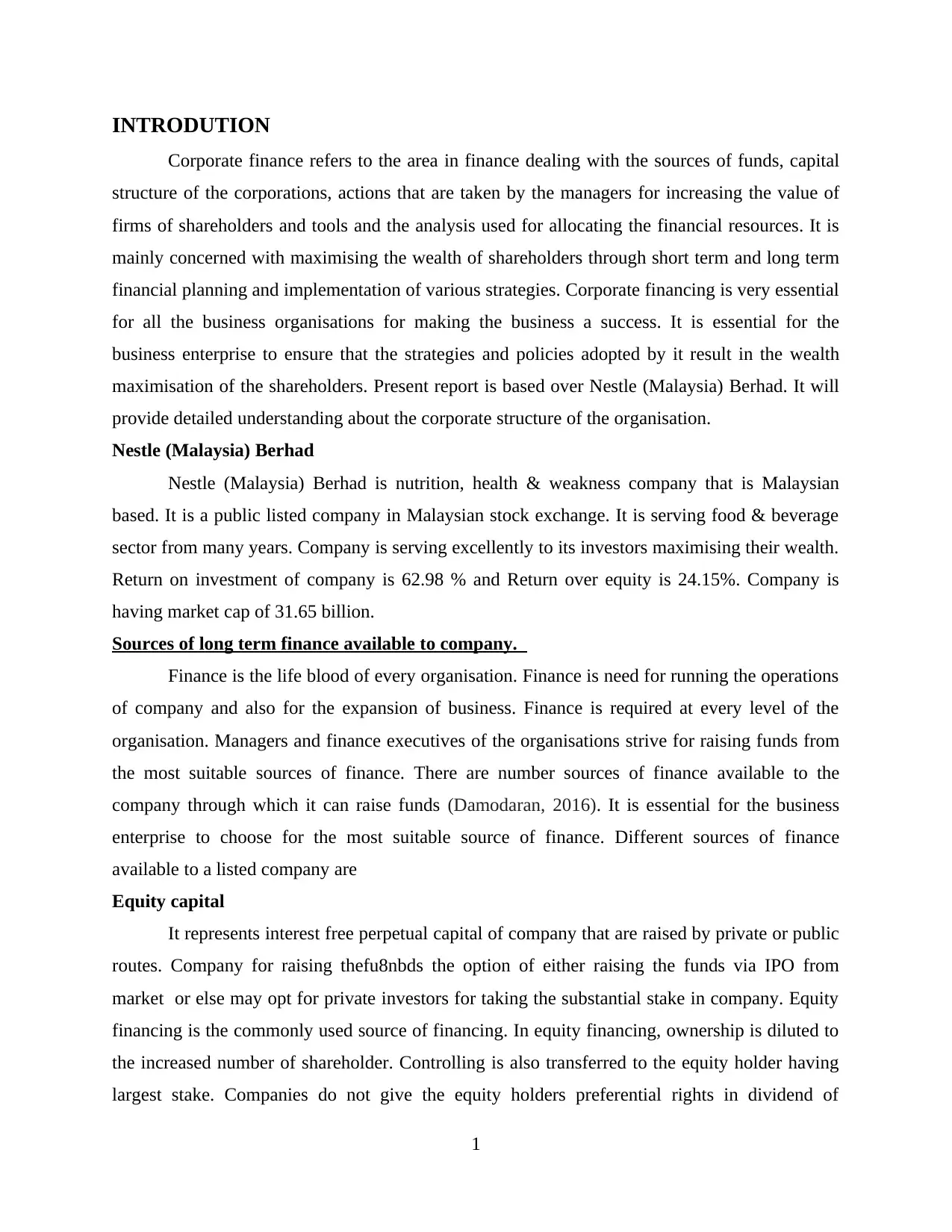
INTRODUTION
Corporate finance refers to the area in finance dealing with the sources of funds, capital
structure of the corporations, actions that are taken by the managers for increasing the value of
firms of shareholders and tools and the analysis used for allocating the financial resources. It is
mainly concerned with maximising the wealth of shareholders through short term and long term
financial planning and implementation of various strategies. Corporate financing is very essential
for all the business organisations for making the business a success. It is essential for the
business enterprise to ensure that the strategies and policies adopted by it result in the wealth
maximisation of the shareholders. Present report is based over Nestle (Malaysia) Berhad. It will
provide detailed understanding about the corporate structure of the organisation.
Nestle (Malaysia) Berhad
Nestle (Malaysia) Berhad is nutrition, health & weakness company that is Malaysian
based. It is a public listed company in Malaysian stock exchange. It is serving food & beverage
sector from many years. Company is serving excellently to its investors maximising their wealth.
Return on investment of company is 62.98 % and Return over equity is 24.15%. Company is
having market cap of 31.65 billion.
Sources of long term finance available to company.
Finance is the life blood of every organisation. Finance is need for running the operations
of company and also for the expansion of business. Finance is required at every level of the
organisation. Managers and finance executives of the organisations strive for raising funds from
the most suitable sources of finance. There are number sources of finance available to the
company through which it can raise funds (Damodaran, 2016). It is essential for the business
enterprise to choose for the most suitable source of finance. Different sources of finance
available to a listed company are
Equity capital
It represents interest free perpetual capital of company that are raised by private or public
routes. Company for raising thefu8nbds the option of either raising the funds via IPO from
market or else may opt for private investors for taking the substantial stake in company. Equity
financing is the commonly used source of financing. In equity financing, ownership is diluted to
the increased number of shareholder. Controlling is also transferred to the equity holder having
largest stake. Companies do not give the equity holders preferential rights in dividend of
1
Corporate finance refers to the area in finance dealing with the sources of funds, capital
structure of the corporations, actions that are taken by the managers for increasing the value of
firms of shareholders and tools and the analysis used for allocating the financial resources. It is
mainly concerned with maximising the wealth of shareholders through short term and long term
financial planning and implementation of various strategies. Corporate financing is very essential
for all the business organisations for making the business a success. It is essential for the
business enterprise to ensure that the strategies and policies adopted by it result in the wealth
maximisation of the shareholders. Present report is based over Nestle (Malaysia) Berhad. It will
provide detailed understanding about the corporate structure of the organisation.
Nestle (Malaysia) Berhad
Nestle (Malaysia) Berhad is nutrition, health & weakness company that is Malaysian
based. It is a public listed company in Malaysian stock exchange. It is serving food & beverage
sector from many years. Company is serving excellently to its investors maximising their wealth.
Return on investment of company is 62.98 % and Return over equity is 24.15%. Company is
having market cap of 31.65 billion.
Sources of long term finance available to company.
Finance is the life blood of every organisation. Finance is need for running the operations
of company and also for the expansion of business. Finance is required at every level of the
organisation. Managers and finance executives of the organisations strive for raising funds from
the most suitable sources of finance. There are number sources of finance available to the
company through which it can raise funds (Damodaran, 2016). It is essential for the business
enterprise to choose for the most suitable source of finance. Different sources of finance
available to a listed company are
Equity capital
It represents interest free perpetual capital of company that are raised by private or public
routes. Company for raising thefu8nbds the option of either raising the funds via IPO from
market or else may opt for private investors for taking the substantial stake in company. Equity
financing is the commonly used source of financing. In equity financing, ownership is diluted to
the increased number of shareholder. Controlling is also transferred to the equity holder having
largest stake. Companies do not give the equity holders preferential rights in dividend of
1
⊘ This is a preview!⊘
Do you want full access?
Subscribe today to unlock all pages.

Trusted by 1+ million students worldwide
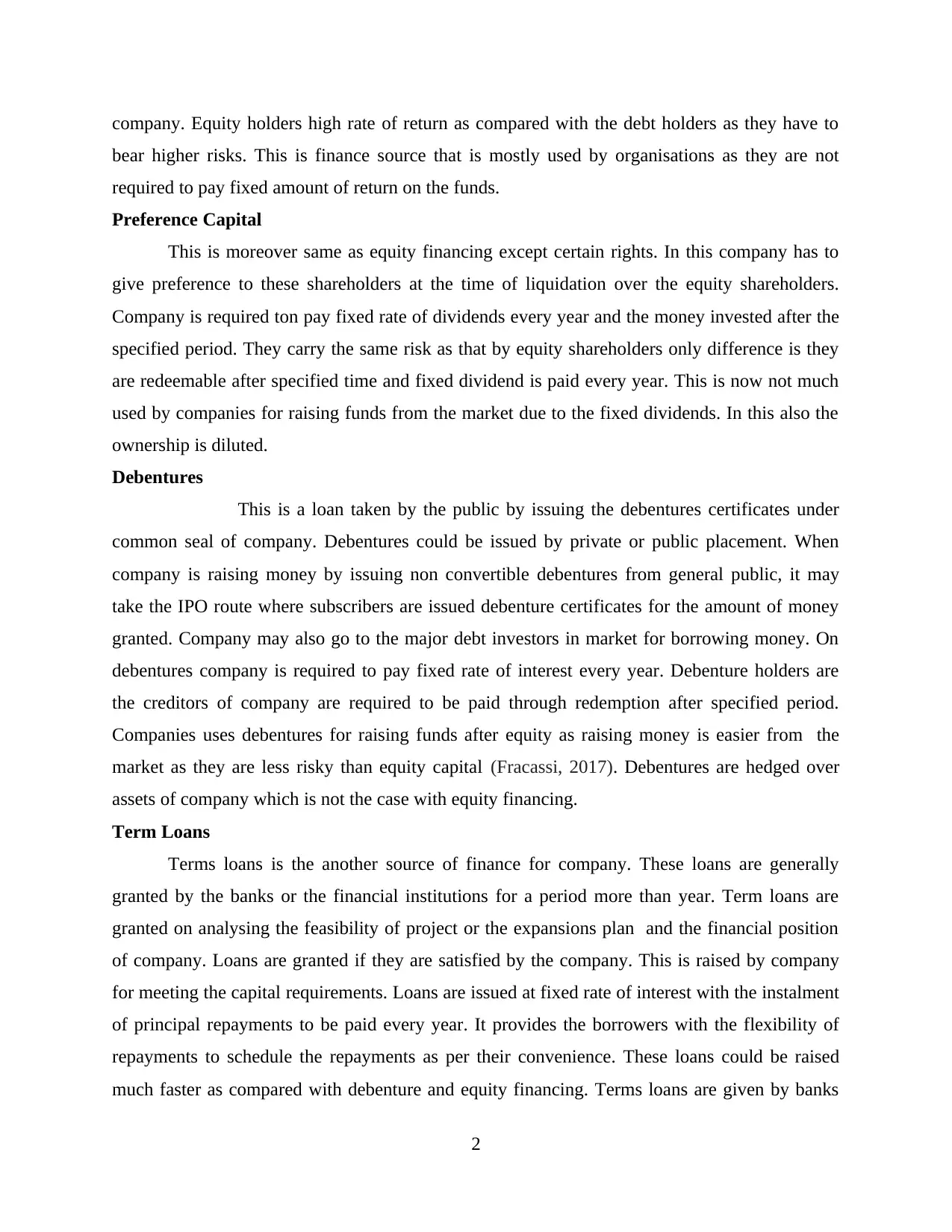
company. Equity holders high rate of return as compared with the debt holders as they have to
bear higher risks. This is finance source that is mostly used by organisations as they are not
required to pay fixed amount of return on the funds.
Preference Capital
This is moreover same as equity financing except certain rights. In this company has to
give preference to these shareholders at the time of liquidation over the equity shareholders.
Company is required ton pay fixed rate of dividends every year and the money invested after the
specified period. They carry the same risk as that by equity shareholders only difference is they
are redeemable after specified time and fixed dividend is paid every year. This is now not much
used by companies for raising funds from the market due to the fixed dividends. In this also the
ownership is diluted.
Debentures
This is a loan taken by the public by issuing the debentures certificates under
common seal of company. Debentures could be issued by private or public placement. When
company is raising money by issuing non convertible debentures from general public, it may
take the IPO route where subscribers are issued debenture certificates for the amount of money
granted. Company may also go to the major debt investors in market for borrowing money. On
debentures company is required to pay fixed rate of interest every year. Debenture holders are
the creditors of company are required to be paid through redemption after specified period.
Companies uses debentures for raising funds after equity as raising money is easier from the
market as they are less risky than equity capital (Fracassi, 2017). Debentures are hedged over
assets of company which is not the case with equity financing.
Term Loans
Terms loans is the another source of finance for company. These loans are generally
granted by the banks or the financial institutions for a period more than year. Term loans are
granted on analysing the feasibility of project or the expansions plan and the financial position
of company. Loans are granted if they are satisfied by the company. This is raised by company
for meeting the capital requirements. Loans are issued at fixed rate of interest with the instalment
of principal repayments to be paid every year. It provides the borrowers with the flexibility of
repayments to schedule the repayments as per their convenience. These loans could be raised
much faster as compared with debenture and equity financing. Terms loans are given by banks
2
bear higher risks. This is finance source that is mostly used by organisations as they are not
required to pay fixed amount of return on the funds.
Preference Capital
This is moreover same as equity financing except certain rights. In this company has to
give preference to these shareholders at the time of liquidation over the equity shareholders.
Company is required ton pay fixed rate of dividends every year and the money invested after the
specified period. They carry the same risk as that by equity shareholders only difference is they
are redeemable after specified time and fixed dividend is paid every year. This is now not much
used by companies for raising funds from the market due to the fixed dividends. In this also the
ownership is diluted.
Debentures
This is a loan taken by the public by issuing the debentures certificates under
common seal of company. Debentures could be issued by private or public placement. When
company is raising money by issuing non convertible debentures from general public, it may
take the IPO route where subscribers are issued debenture certificates for the amount of money
granted. Company may also go to the major debt investors in market for borrowing money. On
debentures company is required to pay fixed rate of interest every year. Debenture holders are
the creditors of company are required to be paid through redemption after specified period.
Companies uses debentures for raising funds after equity as raising money is easier from the
market as they are less risky than equity capital (Fracassi, 2017). Debentures are hedged over
assets of company which is not the case with equity financing.
Term Loans
Terms loans is the another source of finance for company. These loans are generally
granted by the banks or the financial institutions for a period more than year. Term loans are
granted on analysing the feasibility of project or the expansions plan and the financial position
of company. Loans are granted if they are satisfied by the company. This is raised by company
for meeting the capital requirements. Loans are issued at fixed rate of interest with the instalment
of principal repayments to be paid every year. It provides the borrowers with the flexibility of
repayments to schedule the repayments as per their convenience. These loans could be raised
much faster as compared with debenture and equity financing. Terms loans are given by banks
2
Paraphrase This Document
Need a fresh take? Get an instant paraphrase of this document with our AI Paraphraser
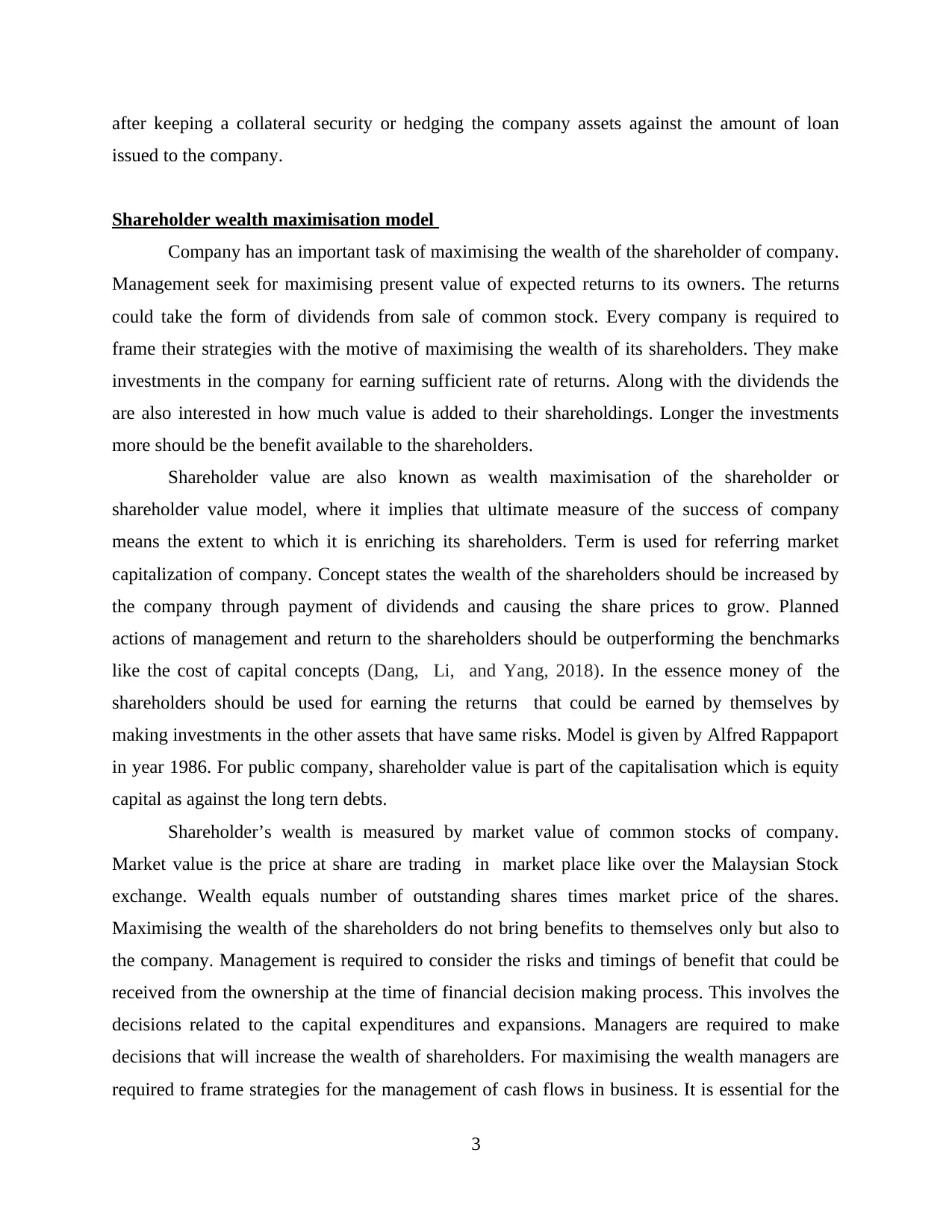
after keeping a collateral security or hedging the company assets against the amount of loan
issued to the company.
Shareholder wealth maximisation model
Company has an important task of maximising the wealth of the shareholder of company.
Management seek for maximising present value of expected returns to its owners. The returns
could take the form of dividends from sale of common stock. Every company is required to
frame their strategies with the motive of maximising the wealth of its shareholders. They make
investments in the company for earning sufficient rate of returns. Along with the dividends the
are also interested in how much value is added to their shareholdings. Longer the investments
more should be the benefit available to the shareholders.
Shareholder value are also known as wealth maximisation of the shareholder or
shareholder value model, where it implies that ultimate measure of the success of company
means the extent to which it is enriching its shareholders. Term is used for referring market
capitalization of company. Concept states the wealth of the shareholders should be increased by
the company through payment of dividends and causing the share prices to grow. Planned
actions of management and return to the shareholders should be outperforming the benchmarks
like the cost of capital concepts (Dang, Li, and Yang, 2018). In the essence money of the
shareholders should be used for earning the returns that could be earned by themselves by
making investments in the other assets that have same risks. Model is given by Alfred Rappaport
in year 1986. For public company, shareholder value is part of the capitalisation which is equity
capital as against the long tern debts.
Shareholder’s wealth is measured by market value of common stocks of company.
Market value is the price at share are trading in market place like over the Malaysian Stock
exchange. Wealth equals number of outstanding shares times market price of the shares.
Maximising the wealth of the shareholders do not bring benefits to themselves only but also to
the company. Management is required to consider the risks and timings of benefit that could be
received from the ownership at the time of financial decision making process. This involves the
decisions related to the capital expenditures and expansions. Managers are required to make
decisions that will increase the wealth of shareholders. For maximising the wealth managers are
required to frame strategies for the management of cash flows in business. It is essential for the
3
issued to the company.
Shareholder wealth maximisation model
Company has an important task of maximising the wealth of the shareholder of company.
Management seek for maximising present value of expected returns to its owners. The returns
could take the form of dividends from sale of common stock. Every company is required to
frame their strategies with the motive of maximising the wealth of its shareholders. They make
investments in the company for earning sufficient rate of returns. Along with the dividends the
are also interested in how much value is added to their shareholdings. Longer the investments
more should be the benefit available to the shareholders.
Shareholder value are also known as wealth maximisation of the shareholder or
shareholder value model, where it implies that ultimate measure of the success of company
means the extent to which it is enriching its shareholders. Term is used for referring market
capitalization of company. Concept states the wealth of the shareholders should be increased by
the company through payment of dividends and causing the share prices to grow. Planned
actions of management and return to the shareholders should be outperforming the benchmarks
like the cost of capital concepts (Dang, Li, and Yang, 2018). In the essence money of the
shareholders should be used for earning the returns that could be earned by themselves by
making investments in the other assets that have same risks. Model is given by Alfred Rappaport
in year 1986. For public company, shareholder value is part of the capitalisation which is equity
capital as against the long tern debts.
Shareholder’s wealth is measured by market value of common stocks of company.
Market value is the price at share are trading in market place like over the Malaysian Stock
exchange. Wealth equals number of outstanding shares times market price of the shares.
Maximising the wealth of the shareholders do not bring benefits to themselves only but also to
the company. Management is required to consider the risks and timings of benefit that could be
received from the ownership at the time of financial decision making process. This involves the
decisions related to the capital expenditures and expansions. Managers are required to make
decisions that will increase the wealth of shareholders. For maximising the wealth managers are
required to frame strategies for the management of cash flows in business. It is essential for the
3
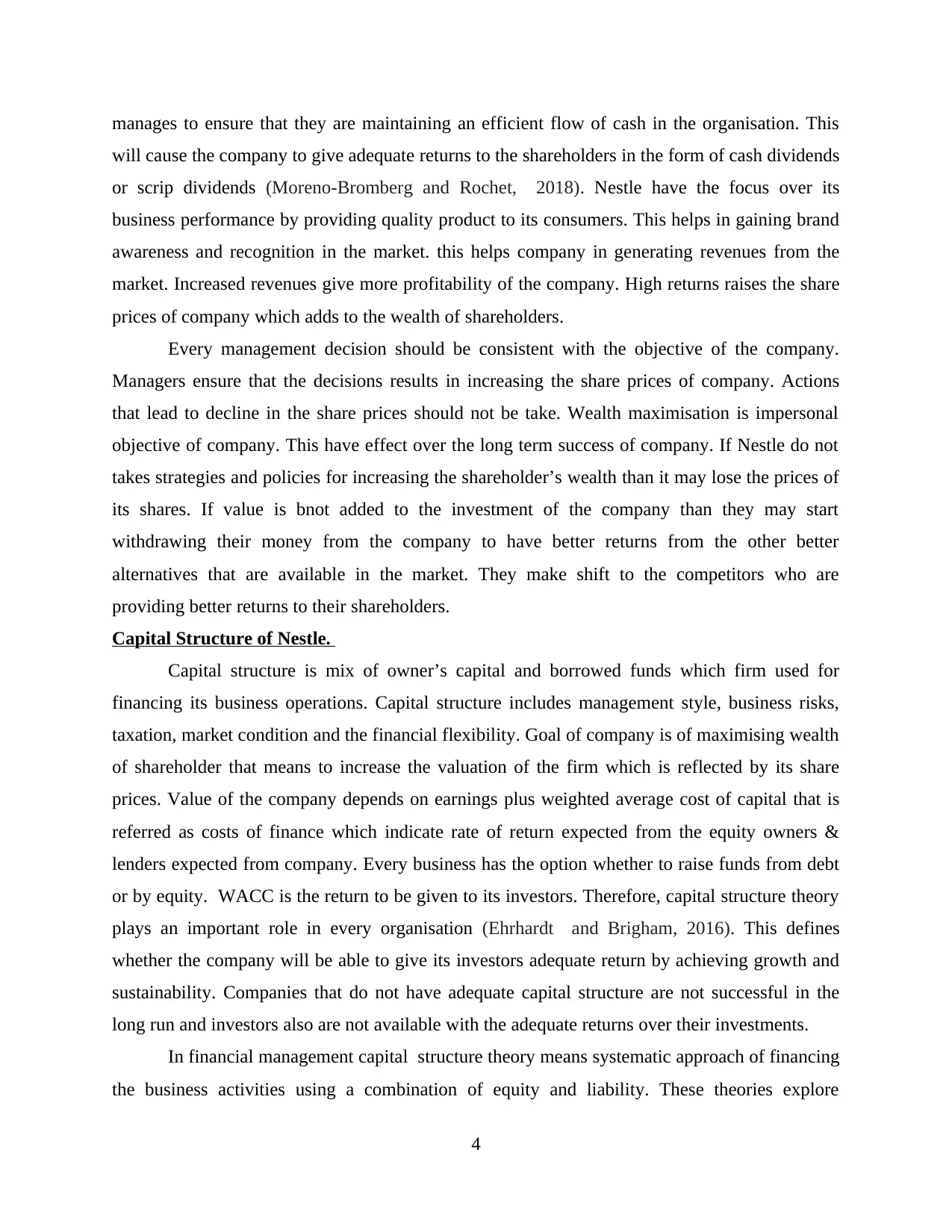
manages to ensure that they are maintaining an efficient flow of cash in the organisation. This
will cause the company to give adequate returns to the shareholders in the form of cash dividends
or scrip dividends (Moreno-Bromberg and Rochet, 2018). Nestle have the focus over its
business performance by providing quality product to its consumers. This helps in gaining brand
awareness and recognition in the market. this helps company in generating revenues from the
market. Increased revenues give more profitability of the company. High returns raises the share
prices of company which adds to the wealth of shareholders.
Every management decision should be consistent with the objective of the company.
Managers ensure that the decisions results in increasing the share prices of company. Actions
that lead to decline in the share prices should not be take. Wealth maximisation is impersonal
objective of company. This have effect over the long term success of company. If Nestle do not
takes strategies and policies for increasing the shareholder’s wealth than it may lose the prices of
its shares. If value is bnot added to the investment of the company than they may start
withdrawing their money from the company to have better returns from the other better
alternatives that are available in the market. They make shift to the competitors who are
providing better returns to their shareholders.
Capital Structure of Nestle.
Capital structure is mix of owner’s capital and borrowed funds which firm used for
financing its business operations. Capital structure includes management style, business risks,
taxation, market condition and the financial flexibility. Goal of company is of maximising wealth
of shareholder that means to increase the valuation of the firm which is reflected by its share
prices. Value of the company depends on earnings plus weighted average cost of capital that is
referred as costs of finance which indicate rate of return expected from the equity owners &
lenders expected from company. Every business has the option whether to raise funds from debt
or by equity. WACC is the return to be given to its investors. Therefore, capital structure theory
plays an important role in every organisation (Ehrhardt and Brigham, 2016). This defines
whether the company will be able to give its investors adequate return by achieving growth and
sustainability. Companies that do not have adequate capital structure are not successful in the
long run and investors also are not available with the adequate returns over their investments.
In financial management capital structure theory means systematic approach of financing
the business activities using a combination of equity and liability. These theories explore
4
will cause the company to give adequate returns to the shareholders in the form of cash dividends
or scrip dividends (Moreno-Bromberg and Rochet, 2018). Nestle have the focus over its
business performance by providing quality product to its consumers. This helps in gaining brand
awareness and recognition in the market. this helps company in generating revenues from the
market. Increased revenues give more profitability of the company. High returns raises the share
prices of company which adds to the wealth of shareholders.
Every management decision should be consistent with the objective of the company.
Managers ensure that the decisions results in increasing the share prices of company. Actions
that lead to decline in the share prices should not be take. Wealth maximisation is impersonal
objective of company. This have effect over the long term success of company. If Nestle do not
takes strategies and policies for increasing the shareholder’s wealth than it may lose the prices of
its shares. If value is bnot added to the investment of the company than they may start
withdrawing their money from the company to have better returns from the other better
alternatives that are available in the market. They make shift to the competitors who are
providing better returns to their shareholders.
Capital Structure of Nestle.
Capital structure is mix of owner’s capital and borrowed funds which firm used for
financing its business operations. Capital structure includes management style, business risks,
taxation, market condition and the financial flexibility. Goal of company is of maximising wealth
of shareholder that means to increase the valuation of the firm which is reflected by its share
prices. Value of the company depends on earnings plus weighted average cost of capital that is
referred as costs of finance which indicate rate of return expected from the equity owners &
lenders expected from company. Every business has the option whether to raise funds from debt
or by equity. WACC is the return to be given to its investors. Therefore, capital structure theory
plays an important role in every organisation (Ehrhardt and Brigham, 2016). This defines
whether the company will be able to give its investors adequate return by achieving growth and
sustainability. Companies that do not have adequate capital structure are not successful in the
long run and investors also are not available with the adequate returns over their investments.
In financial management capital structure theory means systematic approach of financing
the business activities using a combination of equity and liability. These theories explore
4
⊘ This is a preview!⊘
Do you want full access?
Subscribe today to unlock all pages.

Trusted by 1+ million students worldwide

relationship between the debt financing and equity financing. It is stated that the changes in the
financial leverage results in the change of capital cost of company. For example increase in debt
ratio results in increase in the capital structure and also the weighted average cost of capital of
company resulting in higher value for the firm. Cost of capital could be referred as the function
of capital structure. Every company strives for having optimal capital structure. This is achieved
by having an appropriate mix of debt and equity capital so that cost of capital is minimum and
the value of the firm is at maximum.
Nestle is also having adequate capital structure that is the reason why company is able to
provide its investors with the maximum returns. Company is performing excellently well in the
market and therefore is able to provide its shareholders adequate returns over the investments in
share capital. Managers are efficiently managing the capital structures keeping the cost of
capital to the minimum and increasing the value of firm. It is having optimal structure of capital
in debt and equity. Debt to equity ratio of company is 69.63 as per the latest results of stock
exchange. This shows that it is having around 70% of debt as against its equity. Interest coverage
ratio is 22.57% that means the interest required to be paid over their long term debts. Long term
debts of the company as against its total capital are 15.68%.
Financial ratios shows that company uses more of the debt financing as compared with
the equity source of raising funds. The increased debt capital means that firm is highly leveraged.
When the equity capital is low profits are less shared and this increases the earning per share of
the company. Higher earnings represents positive image of the company in market, increased
earnings hits the share prices to go up. This increases the shareholders wealth and valuation of
company. On the other high debt also represent high financial risks. Company is required to pay
considerable amount of earnings for payment of interest over the debt financing (Atanasov and
Black, 2016). Raising funds through debt keeps the cost of capital of the company as the cost of
equity is higher as compared with debts as they are available with tax benefits. Seeing the capital
structure it could be said that company should raise funds through issue of share of equity funds
rather than debt. Increasing debts higher than 70% will be directly the profitability of company.
financial risks will reduce the wealth of shareholders decreasing the shares prices of company.
Computation of the WACC of Nestle (Malaysia) Bhd.
Computation of cost of capital
5
financial leverage results in the change of capital cost of company. For example increase in debt
ratio results in increase in the capital structure and also the weighted average cost of capital of
company resulting in higher value for the firm. Cost of capital could be referred as the function
of capital structure. Every company strives for having optimal capital structure. This is achieved
by having an appropriate mix of debt and equity capital so that cost of capital is minimum and
the value of the firm is at maximum.
Nestle is also having adequate capital structure that is the reason why company is able to
provide its investors with the maximum returns. Company is performing excellently well in the
market and therefore is able to provide its shareholders adequate returns over the investments in
share capital. Managers are efficiently managing the capital structures keeping the cost of
capital to the minimum and increasing the value of firm. It is having optimal structure of capital
in debt and equity. Debt to equity ratio of company is 69.63 as per the latest results of stock
exchange. This shows that it is having around 70% of debt as against its equity. Interest coverage
ratio is 22.57% that means the interest required to be paid over their long term debts. Long term
debts of the company as against its total capital are 15.68%.
Financial ratios shows that company uses more of the debt financing as compared with
the equity source of raising funds. The increased debt capital means that firm is highly leveraged.
When the equity capital is low profits are less shared and this increases the earning per share of
the company. Higher earnings represents positive image of the company in market, increased
earnings hits the share prices to go up. This increases the shareholders wealth and valuation of
company. On the other high debt also represent high financial risks. Company is required to pay
considerable amount of earnings for payment of interest over the debt financing (Atanasov and
Black, 2016). Raising funds through debt keeps the cost of capital of the company as the cost of
equity is higher as compared with debts as they are available with tax benefits. Seeing the capital
structure it could be said that company should raise funds through issue of share of equity funds
rather than debt. Increasing debts higher than 70% will be directly the profitability of company.
financial risks will reduce the wealth of shareholders decreasing the shares prices of company.
Computation of the WACC of Nestle (Malaysia) Bhd.
Computation of cost of capital
5
Paraphrase This Document
Need a fresh take? Get an instant paraphrase of this document with our AI Paraphraser
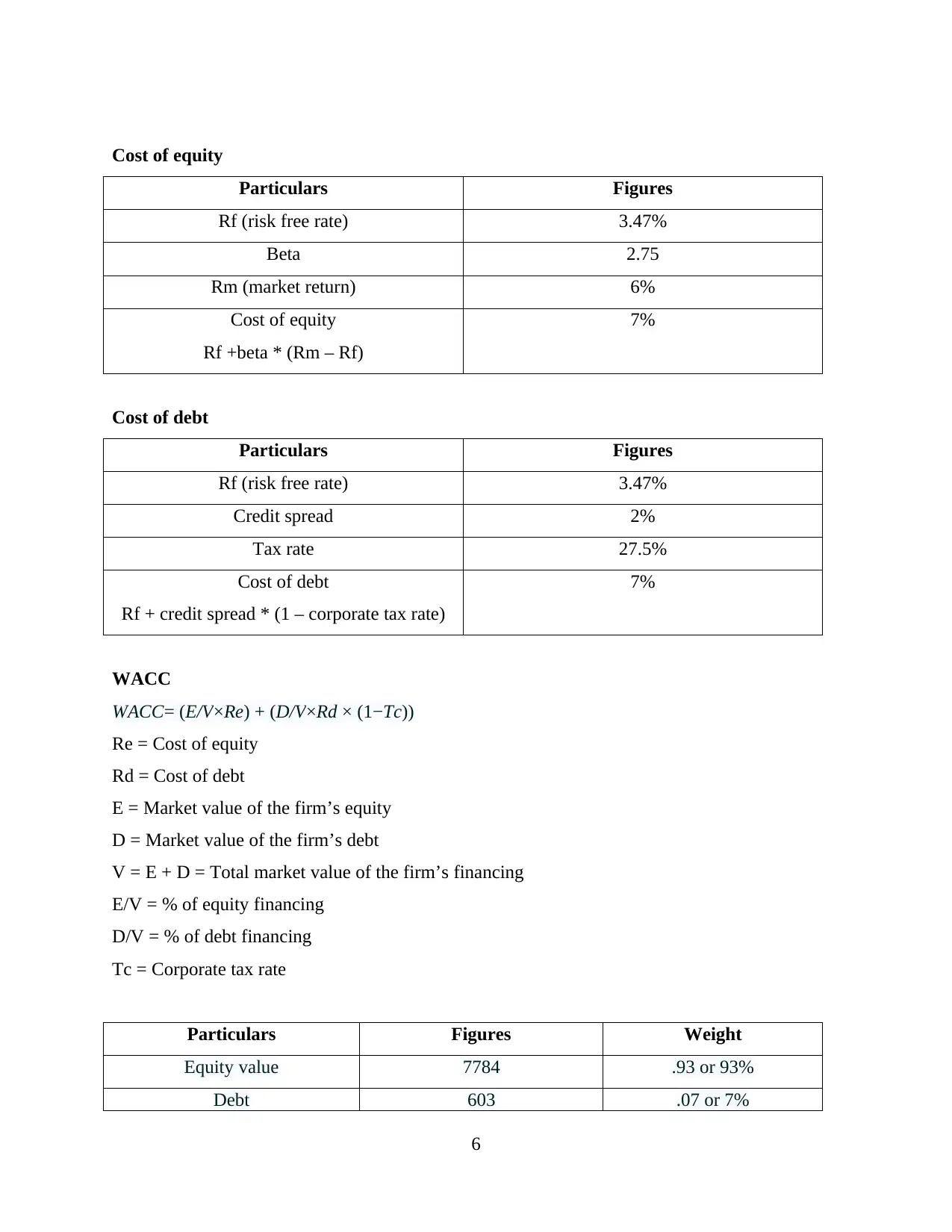
Cost of equity
Particulars Figures
Rf (risk free rate) 3.47%
Beta 2.75
Rm (market return) 6%
Cost of equity
Rf +beta * (Rm – Rf)
7%
Cost of debt
Particulars Figures
Rf (risk free rate) 3.47%
Credit spread 2%
Tax rate 27.5%
Cost of debt
Rf + credit spread * (1 – corporate tax rate)
7%
WACC
WACC= (E/V×Re) + (D/V×Rd × (1−Tc))
Re = Cost of equity
Rd = Cost of debt
E = Market value of the firm’s equity
D = Market value of the firm’s debt
V = E + D = Total market value of the firm’s financing
E/V = % of equity financing
D/V = % of debt financing
Tc = Corporate tax rate
Particulars Figures Weight
Equity value 7784 .93 or 93%
Debt 603 .07 or 7%
6
Particulars Figures
Rf (risk free rate) 3.47%
Beta 2.75
Rm (market return) 6%
Cost of equity
Rf +beta * (Rm – Rf)
7%
Cost of debt
Particulars Figures
Rf (risk free rate) 3.47%
Credit spread 2%
Tax rate 27.5%
Cost of debt
Rf + credit spread * (1 – corporate tax rate)
7%
WACC
WACC= (E/V×Re) + (D/V×Rd × (1−Tc))
Re = Cost of equity
Rd = Cost of debt
E = Market value of the firm’s equity
D = Market value of the firm’s debt
V = E + D = Total market value of the firm’s financing
E/V = % of equity financing
D/V = % of debt financing
Tc = Corporate tax rate
Particulars Figures Weight
Equity value 7784 .93 or 93%
Debt 603 .07 or 7%
6
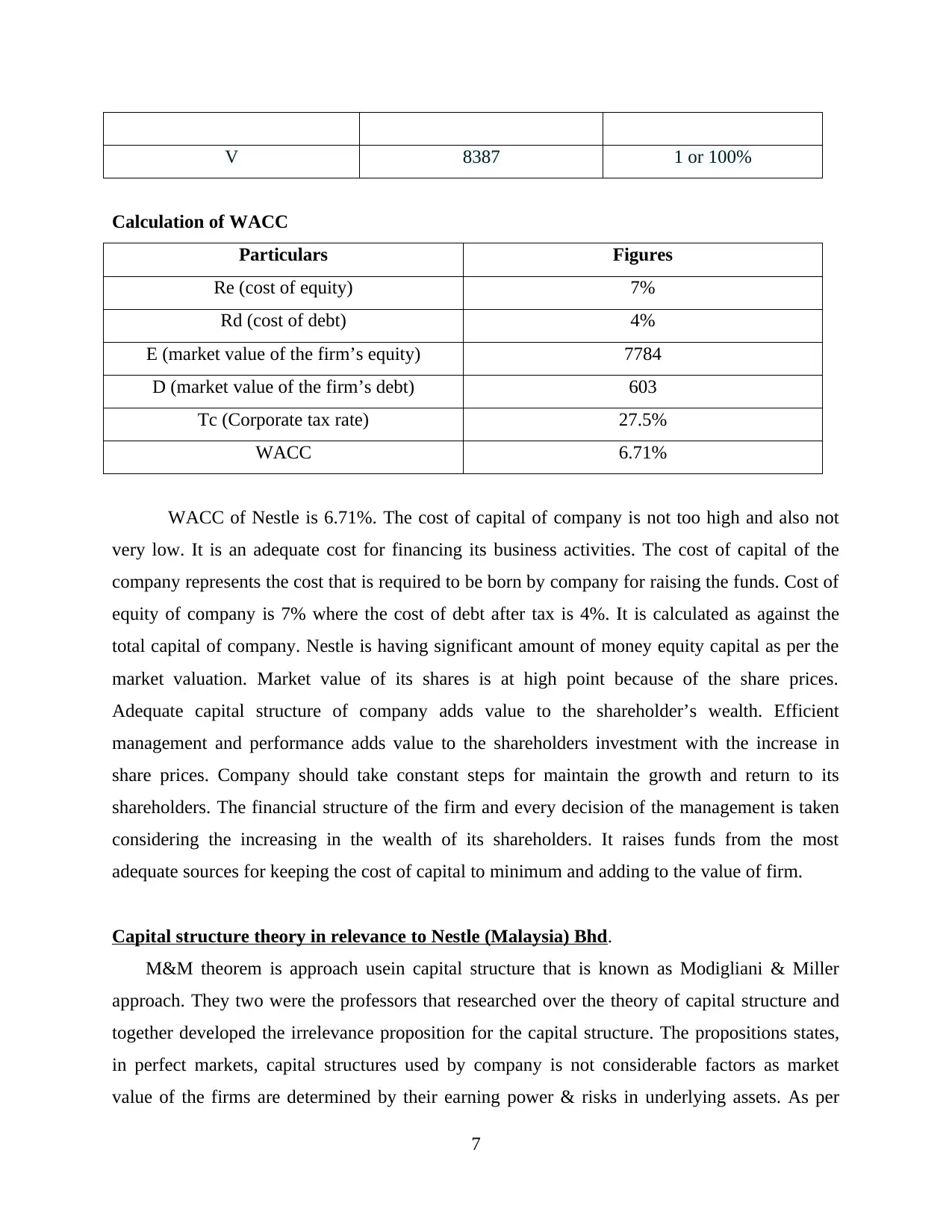
V 8387 1 or 100%
Calculation of WACC
Particulars Figures
Re (cost of equity) 7%
Rd (cost of debt) 4%
E (market value of the firm’s equity) 7784
D (market value of the firm’s debt) 603
Tc (Corporate tax rate) 27.5%
WACC 6.71%
WACC of Nestle is 6.71%. The cost of capital of company is not too high and also not
very low. It is an adequate cost for financing its business activities. The cost of capital of the
company represents the cost that is required to be born by company for raising the funds. Cost of
equity of company is 7% where the cost of debt after tax is 4%. It is calculated as against the
total capital of company. Nestle is having significant amount of money equity capital as per the
market valuation. Market value of its shares is at high point because of the share prices.
Adequate capital structure of company adds value to the shareholder’s wealth. Efficient
management and performance adds value to the shareholders investment with the increase in
share prices. Company should take constant steps for maintain the growth and return to its
shareholders. The financial structure of the firm and every decision of the management is taken
considering the increasing in the wealth of its shareholders. It raises funds from the most
adequate sources for keeping the cost of capital to minimum and adding to the value of firm.
Capital structure theory in relevance to Nestle (Malaysia) Bhd.
M&M theorem is approach usein capital structure that is known as Modigliani & Miller
approach. They two were the professors that researched over the theory of capital structure and
together developed the irrelevance proposition for the capital structure. The propositions states,
in perfect markets, capital structures used by company is not considerable factors as market
value of the firms are determined by their earning power & risks in underlying assets. As per
7
Calculation of WACC
Particulars Figures
Re (cost of equity) 7%
Rd (cost of debt) 4%
E (market value of the firm’s equity) 7784
D (market value of the firm’s debt) 603
Tc (Corporate tax rate) 27.5%
WACC 6.71%
WACC of Nestle is 6.71%. The cost of capital of company is not too high and also not
very low. It is an adequate cost for financing its business activities. The cost of capital of the
company represents the cost that is required to be born by company for raising the funds. Cost of
equity of company is 7% where the cost of debt after tax is 4%. It is calculated as against the
total capital of company. Nestle is having significant amount of money equity capital as per the
market valuation. Market value of its shares is at high point because of the share prices.
Adequate capital structure of company adds value to the shareholder’s wealth. Efficient
management and performance adds value to the shareholders investment with the increase in
share prices. Company should take constant steps for maintain the growth and return to its
shareholders. The financial structure of the firm and every decision of the management is taken
considering the increasing in the wealth of its shareholders. It raises funds from the most
adequate sources for keeping the cost of capital to minimum and adding to the value of firm.
Capital structure theory in relevance to Nestle (Malaysia) Bhd.
M&M theorem is approach usein capital structure that is known as Modigliani & Miller
approach. They two were the professors that researched over the theory of capital structure and
together developed the irrelevance proposition for the capital structure. The propositions states,
in perfect markets, capital structures used by company is not considerable factors as market
value of the firms are determined by their earning power & risks in underlying assets. As per
7
⊘ This is a preview!⊘
Do you want full access?
Subscribe today to unlock all pages.

Trusted by 1+ million students worldwide
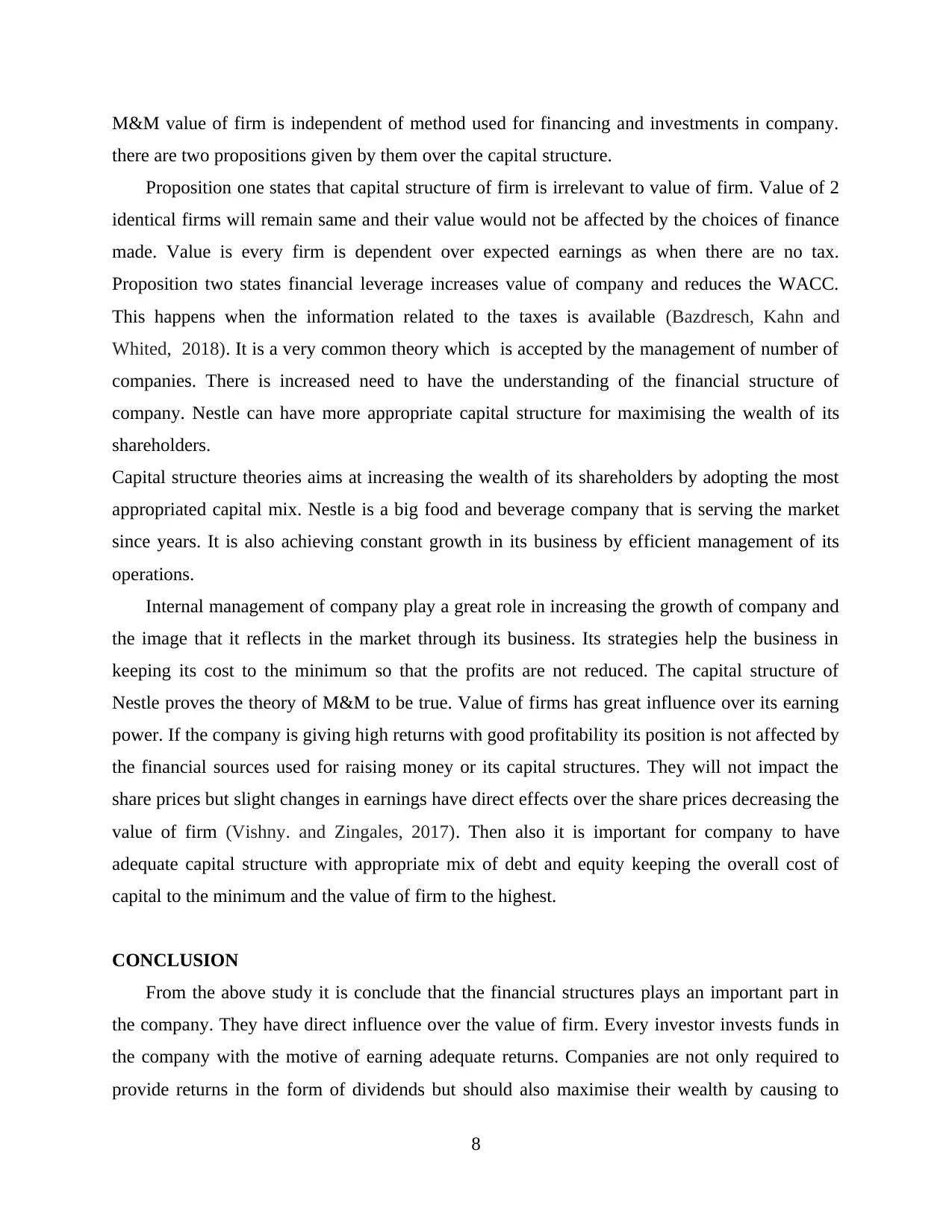
M&M value of firm is independent of method used for financing and investments in company.
there are two propositions given by them over the capital structure.
Proposition one states that capital structure of firm is irrelevant to value of firm. Value of 2
identical firms will remain same and their value would not be affected by the choices of finance
made. Value is every firm is dependent over expected earnings as when there are no tax.
Proposition two states financial leverage increases value of company and reduces the WACC.
This happens when the information related to the taxes is available (Bazdresch, Kahn and
Whited, 2018). It is a very common theory which is accepted by the management of number of
companies. There is increased need to have the understanding of the financial structure of
company. Nestle can have more appropriate capital structure for maximising the wealth of its
shareholders.
Capital structure theories aims at increasing the wealth of its shareholders by adopting the most
appropriated capital mix. Nestle is a big food and beverage company that is serving the market
since years. It is also achieving constant growth in its business by efficient management of its
operations.
Internal management of company play a great role in increasing the growth of company and
the image that it reflects in the market through its business. Its strategies help the business in
keeping its cost to the minimum so that the profits are not reduced. The capital structure of
Nestle proves the theory of M&M to be true. Value of firms has great influence over its earning
power. If the company is giving high returns with good profitability its position is not affected by
the financial sources used for raising money or its capital structures. They will not impact the
share prices but slight changes in earnings have direct effects over the share prices decreasing the
value of firm (Vishny. and Zingales, 2017). Then also it is important for company to have
adequate capital structure with appropriate mix of debt and equity keeping the overall cost of
capital to the minimum and the value of firm to the highest.
CONCLUSION
From the above study it is conclude that the financial structures plays an important part in
the company. They have direct influence over the value of firm. Every investor invests funds in
the company with the motive of earning adequate returns. Companies are not only required to
provide returns in the form of dividends but should also maximise their wealth by causing to
8
there are two propositions given by them over the capital structure.
Proposition one states that capital structure of firm is irrelevant to value of firm. Value of 2
identical firms will remain same and their value would not be affected by the choices of finance
made. Value is every firm is dependent over expected earnings as when there are no tax.
Proposition two states financial leverage increases value of company and reduces the WACC.
This happens when the information related to the taxes is available (Bazdresch, Kahn and
Whited, 2018). It is a very common theory which is accepted by the management of number of
companies. There is increased need to have the understanding of the financial structure of
company. Nestle can have more appropriate capital structure for maximising the wealth of its
shareholders.
Capital structure theories aims at increasing the wealth of its shareholders by adopting the most
appropriated capital mix. Nestle is a big food and beverage company that is serving the market
since years. It is also achieving constant growth in its business by efficient management of its
operations.
Internal management of company play a great role in increasing the growth of company and
the image that it reflects in the market through its business. Its strategies help the business in
keeping its cost to the minimum so that the profits are not reduced. The capital structure of
Nestle proves the theory of M&M to be true. Value of firms has great influence over its earning
power. If the company is giving high returns with good profitability its position is not affected by
the financial sources used for raising money or its capital structures. They will not impact the
share prices but slight changes in earnings have direct effects over the share prices decreasing the
value of firm (Vishny. and Zingales, 2017). Then also it is important for company to have
adequate capital structure with appropriate mix of debt and equity keeping the overall cost of
capital to the minimum and the value of firm to the highest.
CONCLUSION
From the above study it is conclude that the financial structures plays an important part in
the company. They have direct influence over the value of firm. Every investor invests funds in
the company with the motive of earning adequate returns. Companies are not only required to
provide returns in the form of dividends but should also maximise their wealth by causing to
8
Paraphrase This Document
Need a fresh take? Get an instant paraphrase of this document with our AI Paraphraser
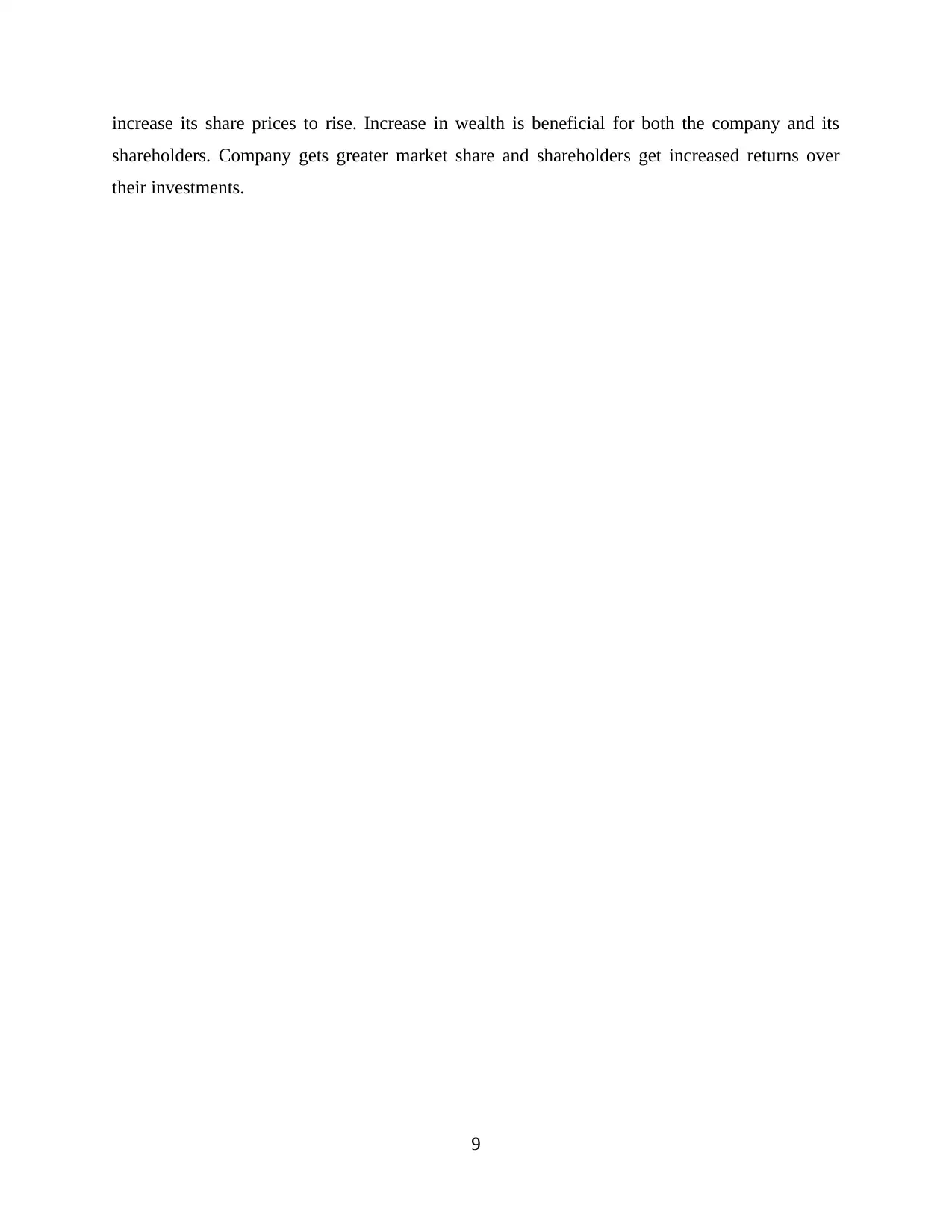
increase its share prices to rise. Increase in wealth is beneficial for both the company and its
shareholders. Company gets greater market share and shareholders get increased returns over
their investments.
9
shareholders. Company gets greater market share and shareholders get increased returns over
their investments.
9
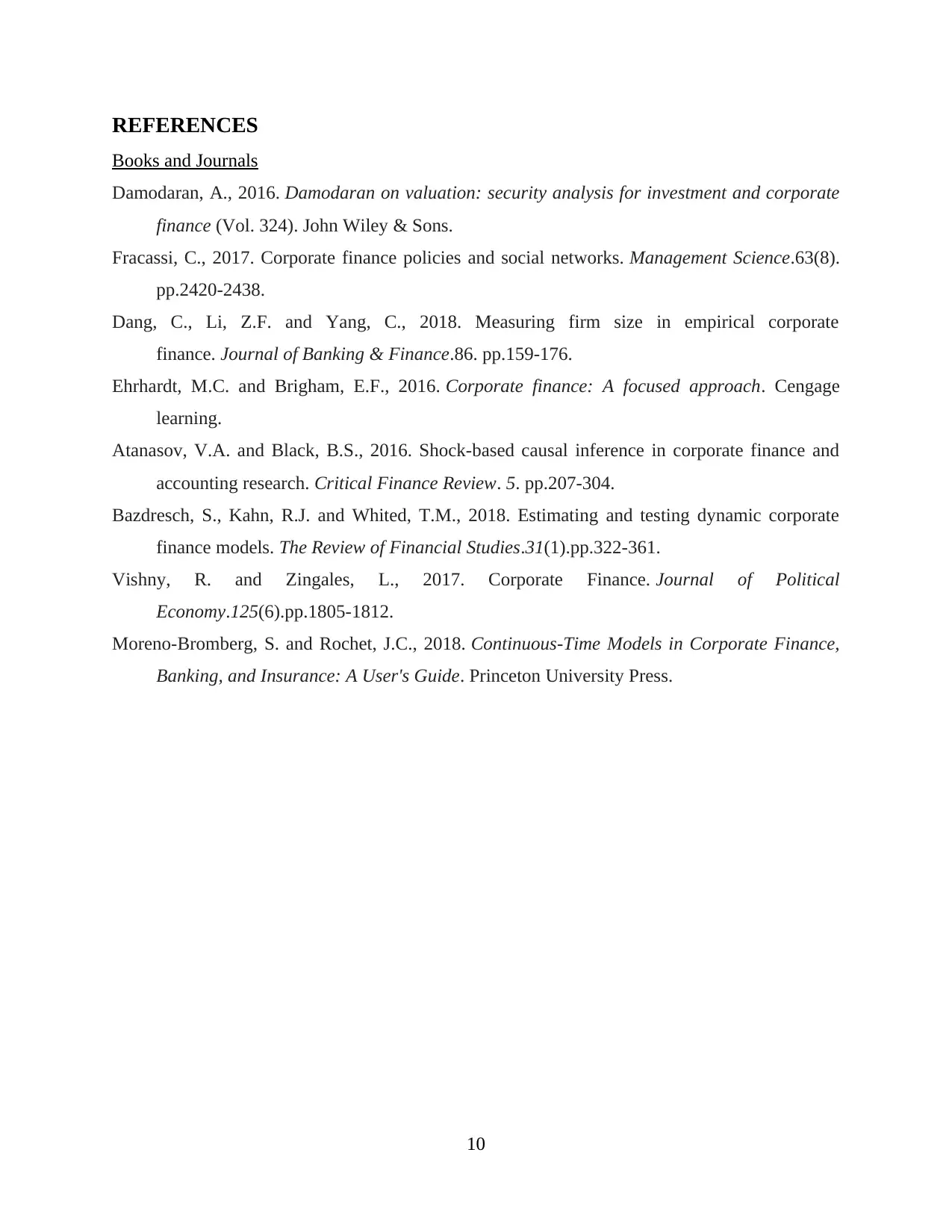
REFERENCES
Books and Journals
Damodaran, A., 2016. Damodaran on valuation: security analysis for investment and corporate
finance (Vol. 324). John Wiley & Sons.
Fracassi, C., 2017. Corporate finance policies and social networks. Management Science.63(8).
pp.2420-2438.
Dang, C., Li, Z.F. and Yang, C., 2018. Measuring firm size in empirical corporate
finance. Journal of Banking & Finance.86. pp.159-176.
Ehrhardt, M.C. and Brigham, E.F., 2016. Corporate finance: A focused approach. Cengage
learning.
Atanasov, V.A. and Black, B.S., 2016. Shock-based causal inference in corporate finance and
accounting research. Critical Finance Review. 5. pp.207-304.
Bazdresch, S., Kahn, R.J. and Whited, T.M., 2018. Estimating and testing dynamic corporate
finance models. The Review of Financial Studies.31(1).pp.322-361.
Vishny, R. and Zingales, L., 2017. Corporate Finance. Journal of Political
Economy.125(6).pp.1805-1812.
Moreno-Bromberg, S. and Rochet, J.C., 2018. Continuous-Time Models in Corporate Finance,
Banking, and Insurance: A User's Guide. Princeton University Press.
10
Books and Journals
Damodaran, A., 2016. Damodaran on valuation: security analysis for investment and corporate
finance (Vol. 324). John Wiley & Sons.
Fracassi, C., 2017. Corporate finance policies and social networks. Management Science.63(8).
pp.2420-2438.
Dang, C., Li, Z.F. and Yang, C., 2018. Measuring firm size in empirical corporate
finance. Journal of Banking & Finance.86. pp.159-176.
Ehrhardt, M.C. and Brigham, E.F., 2016. Corporate finance: A focused approach. Cengage
learning.
Atanasov, V.A. and Black, B.S., 2016. Shock-based causal inference in corporate finance and
accounting research. Critical Finance Review. 5. pp.207-304.
Bazdresch, S., Kahn, R.J. and Whited, T.M., 2018. Estimating and testing dynamic corporate
finance models. The Review of Financial Studies.31(1).pp.322-361.
Vishny, R. and Zingales, L., 2017. Corporate Finance. Journal of Political
Economy.125(6).pp.1805-1812.
Moreno-Bromberg, S. and Rochet, J.C., 2018. Continuous-Time Models in Corporate Finance,
Banking, and Insurance: A User's Guide. Princeton University Press.
10
⊘ This is a preview!⊘
Do you want full access?
Subscribe today to unlock all pages.

Trusted by 1+ million students worldwide
1 out of 12
Related Documents
Your All-in-One AI-Powered Toolkit for Academic Success.
+13062052269
info@desklib.com
Available 24*7 on WhatsApp / Email
![[object Object]](/_next/static/media/star-bottom.7253800d.svg)
Unlock your academic potential
Copyright © 2020–2025 A2Z Services. All Rights Reserved. Developed and managed by ZUCOL.





